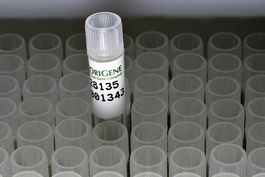OAZ3 (NM_001301371) Human Untagged Clone
CAT#: SC333435
OAZ3 (untagged) - Human ornithine decarboxylase antizyme 3 (OAZ3), transcript variant 3
"NM_001301371" in other vectors (2)
Product Images

Frequently bought together (4)
Other products for "OAZ3"
Specifications
| Product Data | |
| Type | Human Untagged Clone |
| Tag | Tag Free |
| Symbol | OAZ3 |
| Synonyms | AZ3; OAZ-t; TISP15 |
| Vector | pCMV6-Entry |
| E. coli Selection | Kanamycin (25 ug/mL) |
| Mammalian Cell Selection | Neomycin |
| Sequence Data |
>SC333435 representing NM_001301371.
Blue=Insert sequence Red=Cloning site Green=Tag(s) GCTCGTTTAGTGAACCGTCAGAATTTTGTAATACGACTCACTATAGGGCGGCCGGGAATTCGTCGACTG GATCCGGTACCGAGGAGATCTGCCGCCGCGATCGCC ATGAGACCTGAGGGAGGACCCCGGCGTCGGCGGCAGGAAAGGCCCCCGCCAGTGCTGCCTGCGGCGCGC CGCATCACTTATAAGGAAGAGGAGGACTTGACACTCCAGCCCCGTTCCTGCCTCCAGTGCTCCATGAGA CCTGAGGGAGGACCCCGGCGTCGGCGGCAGGAAAGGCCCCCGCCAGTGCTGCCTGCGGCGCGCCGCATC ACTTATAAGGAAGAGGAGGACTTGACACTCCAGCCCCGTTCCTGCCTCCAGTGCTCC ACGCGTACGCGGCCGCTCGAGCAGAAACTCATCTCAGAAGAGGATCTGGCAGCAAATGATATCCTGGAT TACAAGGATGACGACGATAAGGTTTAAACGGCCGGC |
| Restriction Sites | SgfI-MluI |
| ACCN | NM_001301371 |
| Insert Size | 264 bp |
| OTI Disclaimer | Our molecular clone sequence data has been matched to the reference identifier above as a point of reference. Note that the complete sequence of our molecular clones may differ from the sequence published for this corresponding reference, e.g., by representing an alternative RNA splicing form or single nucleotide polymorphism (SNP). |
| Product Components | The ORF clone is ion-exchange column purified and shipped in a 2D barcoded Matrix tube containing 10ug of transfection-ready, dried plasmid DNA (reconstitute with 100 ul of water). |
| Reconstitution | 1. Centrifuge at 5,000xg for 5min. 2. Carefully open the tube and add 100ul of sterile water to dissolve the DNA. 3. Close the tube and incubate for 10 minutes at room temperature. 4. Briefly vortex the tube and then do a quick spin (less than 5000xg) to concentrate the liquid at the bottom. 5. Store the suspended plasmid at -20°C. The DNA is stable for at least one year from date of shipping when stored at -20°C. |
| Reference Data | |
| RefSeq | NM_001301371.1 |
| RefSeq Size | 753 bp |
| RefSeq ORF | 264 bp |
| Locus ID | 51686 |
| UniProt ID | Q9UMX2 |
| Cytogenetics | 1q21.3 |
| MW | 10.3 kDa |
| Gene Summary | The protein encoded by this gene belongs to the ornithine decarboxylase antizyme family, which plays a role in cell growth and proliferation by regulating intracellular polyamine levels. Expression of antizymes requires +1 ribosomal frameshifting, which is enhanced by high levels of polyamines. Antizymes in turn bind to and inhibit ornithine decarboxylase (ODC), the key enzyme in polyamine biosynthesis; thus, completing the auto-regulatory circuit. This gene encodes antizyme 3, the third member of the antizyme family. Like antizymes 1 and 2, antizyme 3 inhibits ODC activity and polyamine uptake; however, it does not stimulate ODC degradation. Also, while antizymes 1 and 2 have broad tissue distribution, expression of antizyme 3 is restricted to haploid germ cells in testis, suggesting a distinct role for this antizyme in spermiogenesis. Antizyme 3 gene knockout studies showed that homozygous mutant male mice were infertile, and indicated the likely role of this antizyme in the formation of a rigid connection between the sperm head and tail during spermatogenesis. Alternatively spliced transcript variants encoding different isoforms, including one resulting from the use of non-AUG (CUG) translation initiation codon, have been found for this gene. [provided by RefSeq, Dec 2014] Transcript Variant: This variant (3) contains an alternate 5' terminal exon and initiates translation from an AUG start codon, compared to variant 1. The resulting isoform (3) is shorter with a distinct N-terminus compared to isoform 1. |
Documents
| Product Manuals |
| FAQs |
| SDS |
Resources
{0} Product Review(s)
0 Product Review(s)
Submit review
Be the first one to submit a review
Product Citations
*Delivery time may vary from web posted schedule. Occasional delays may occur due to unforeseen
complexities in the preparation of your product. International customers may expect an additional 1-2 weeks
in shipping.






























































































































































































































































 Germany
Germany
 Japan
Japan
 United Kingdom
United Kingdom
 China
China
